COPENHAGEN (pop 1.9 million)
Most tourist’s first (and often only) stop in Denmark, it was my last and at the end of 2 weeks seeing almost everything there is to see in Denmark. I purchased the Copenhagen Card – 120 hours for DK899 – that covers 89 museums and attractions and all public transport. I shouldn’t miss much but have a hectic 3 days as I used the card for one day to see Zealand north of Copenhagen.
Copenhagen has the best image of any Nordic city – edgier than Stockholm and worldlier than Oslo. The thousand-year-old harbour is surrounded by cobbled streets and industry on the south. The city is home to a thriving design scene, hip shopping, cafes and bars, world-class museums, and intelligent new architecture. There are at least 15 Michelin-starred restaurants. It is also home to the royal family, the multitalented Queen Margrethe II, and her photogenic family.
History. More than 1000 years ago, a fishing settlement was on the shores of Øresund Strait, the body of water that separates Denmark and Sweden. To protect itself from pirates in the 12th century, a fort was built in the harbour where the present Danish parliament is today. København stands for ‘købe’, to buy and ‘havn’ is for harbour. The city grew north of the harbour founded on the herring fishery and became the capital in the 15th century, moving it from Roskilde.
Denmark’s great Renaissance king, Christian IV (1588-1648) transformed it into an impressive capital that controlled much of Scandinavia. Eventually, he bankrupted the country with his overspending and reckless foreign forays.
By the 19th century, Denmark was greatly diminished and Twice in the early 1800s, Britain blockaded the city, then bounced back with the cultural Golden Age.
TIPS for COPENHAGEN
1. Copenhagen Card. I purchase a 120-hour card in Hillerød for DK899 just before seeing Fredriksborg Slot. It covers 89 museums (including all the ones in north Sealand), all public transportation in Copenhagen (including boat tours) and gives a deal on other attractions.
2. Parking. I was worried about a cheap, convenient place to park in Copenhagen and found free parking 50m from the Tycho Brahe Planetarium on Ved Vesterport Street. It had a nearby free street toilet, lots of garbage containers, and was reasonably close to all the west end attractions and two MacDonalds for free Wi-Fi. Danish parking tickets are in the €100 range and I hate paying for parking. I returned after being there for 3 days to see a ticket. One must buy a parking clock disc to at least give you a chance for parking free.
3. Showers. There are free showers in a sports complex called DGI-byen on the SW side of Central Station. The easiest access is from the end of the bridge that goes over the tracks but I will give one from Central Station. Go down tracks 11-12, up the stairs at the end, turn right and the complex is kitty-corner behind a large climbing wall. On entering the complex, turn right past the table tennis, go down the stairs, take 2 rights and there are great clean showers opposite one of the gymnasiums. I went in the morning and was the only one around and returned 2 days later for the best shower facilities in Europe as they are so quiet. Hours are 6 am to 10 pm on weekdays and 8 am to 7:30 pm on weekends.
4. English bookstore. The best is Arnold Busck, in the pedestrianized old quarter.
Day 1/13
This was an ugly cold, windy, rainy day. And my first day was a Monday when the majority of museums were closed. So I tried to see as many of the sights on the Nomad Mania list open on Monday. It meant a lot of drive-about as most things were on the periphery of the city. It is possible to walk across the core in an hour and travel further easily using public transportation.
Experimentarium. This “science” centre is a great place for kids with tons of hands-on activities: making balls go to different cities in the world, seeing how locks work, etc. More adult-orientated activities were: how your body works and Danish Innovation in the applied science. All are very well done and it is housed in a wonderful building with a copper spiral staircase filling the foyer. DK195
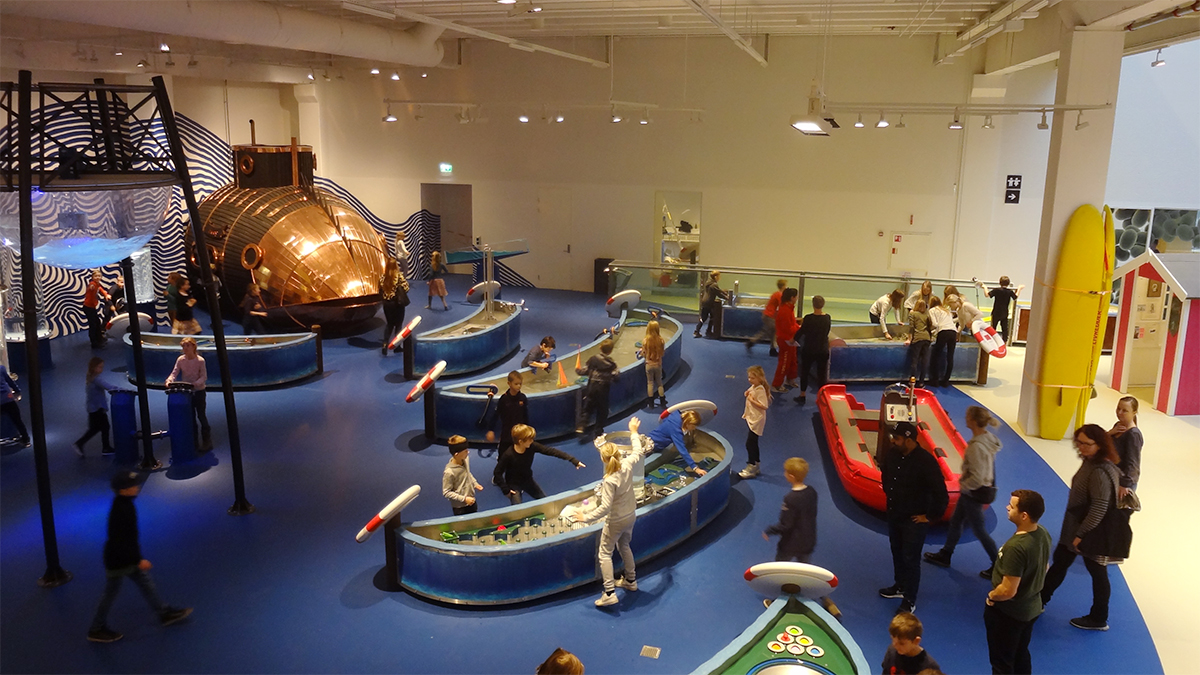
Trekroner Fort. This was a huge drive-about to find the ferry that takes you to this island fortress at the entrance to Copenhagen harbour. First Google maps took me to the ferry to Oslo and then a tortuous 18km drive around to the opposite side of the harbour past a lot of industry and roads never used by anyone to a good viewpoint to see the fort but obviously no ferry. I visited with my binoculars. It is on an artificial island created by sinking the ship Trekroner and used from 1713-1920. A brick wall supports earthen mounds hiding large concrete bunkers. There are 2 lighthouses and two red buildings all surrounding an enclosed harbour with a narrow entrance.


Freetown Christiana. On the south side of the harbour and the district of Christianshavn, this is a commune straddling a curving waterway that was established in 1974 by nonconformists from across the globe. Attracted by a collective, communal lifestyle, it is a wonderland of odd DIY homes accessible only on foot on dirt paths.
I walked along both sides of the water past the oddest collection of houses that appeared to be owned by squatters and was surprised to see that they had water, electrical, and sewer connections. Many are built over the water and are quite attractive and some look disheveled. There is only one walking bridge connecting the sides of the water.
The main entrance is on the other side behind the Vor Freisers Kirke.
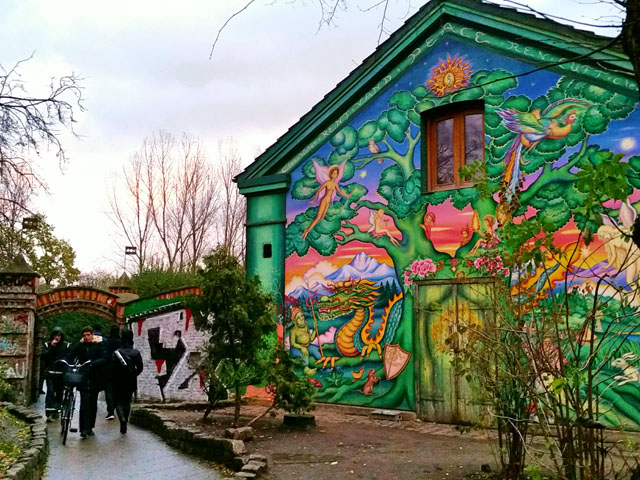

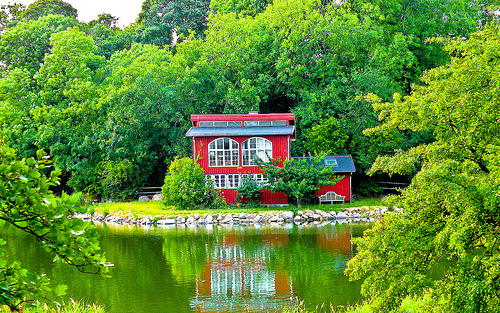
Vor Freisers Kirke (Church of Our Saviour). This 17th-century church with its 95m spired tower dominates the east end of Chrisitanshavn. Inside, the church wows with its elaborately carved pipe organ sitting on 2 elephants from 1698 and an ornate baroque altar with carved statues of four saints on the balustrade. Free

Tietgen Kollegiet. In the centre of the modern University of Copenhagen campus is this student “dorm, a 7-story, round apartment complex that has won many architectural awards. Full of glass and balconies, the dark wood structure encloses a central lawn with trees. The bottom floor has a gym/exercise area, laundromat, air hockey, music room, offices, study halls, and several 2-story bike parks. The traffic-free university is very attractive with its canals and footbridges. Free
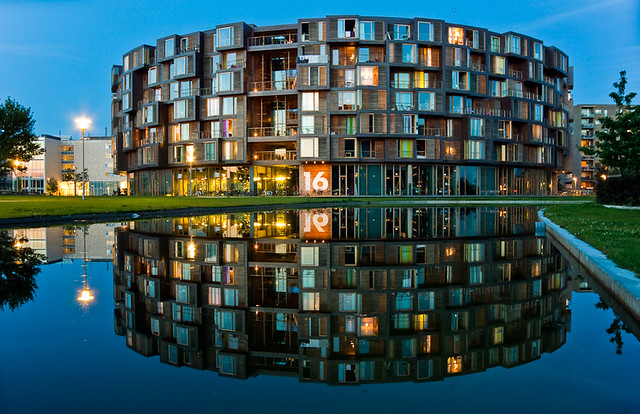
8 House. 8kms to the south of the centre in a high-end area full of apartments and a swank Marriot Hotel. This apartment building is in the NM ‘Modern Architecture’ series. Clad in silver panels, the 9-story complex has balconies angled out creating a wonderful façade. The apartments surround a central green area. The sod ends are sloped at 45°.
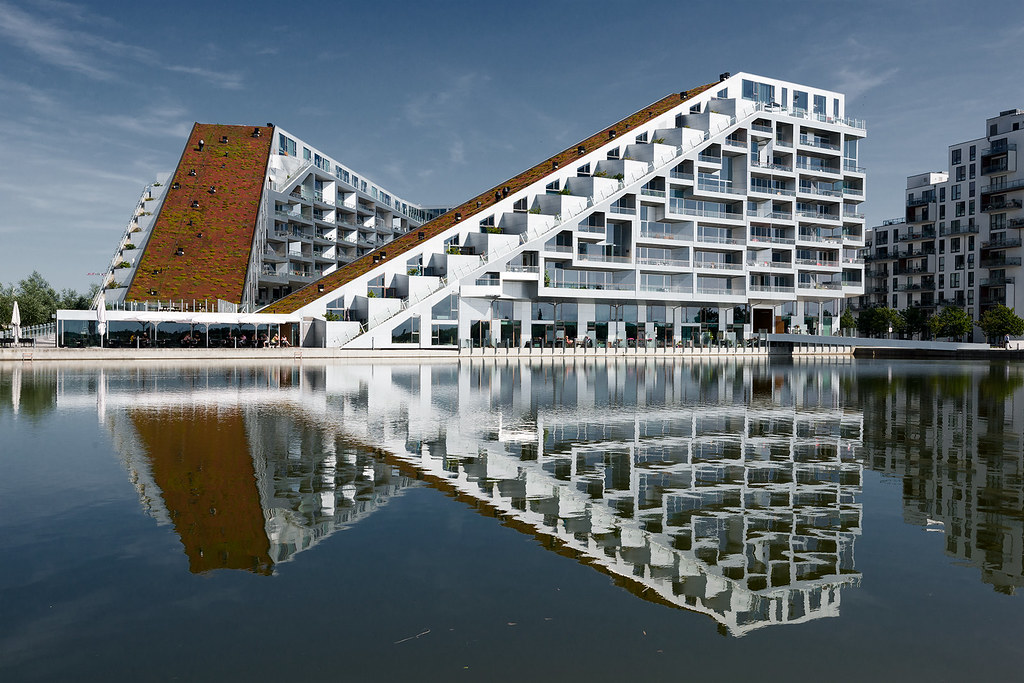

Tycho Brahe Planetarium. In 1572, this astronomer saw a new star forming that was in fact a supernova exploding in the Cassiopeia galaxy and the king gave him the island of Hivn to build an observatory. The exhibits explain supernovas, neutron stars, black holes, and the many ways that elements are formed from hydrogen to zinc, iron, and heavy elements. Carl Sagan is quoted many times. A rotating set of movies are shown in the Dome theatre – I saw “In Search of Life in Space”, a well-done documentary in English.
The attractive exterior has alternating bands of red and cream brick with a soaring cylinder rising from the back that has the theatre. DK190.
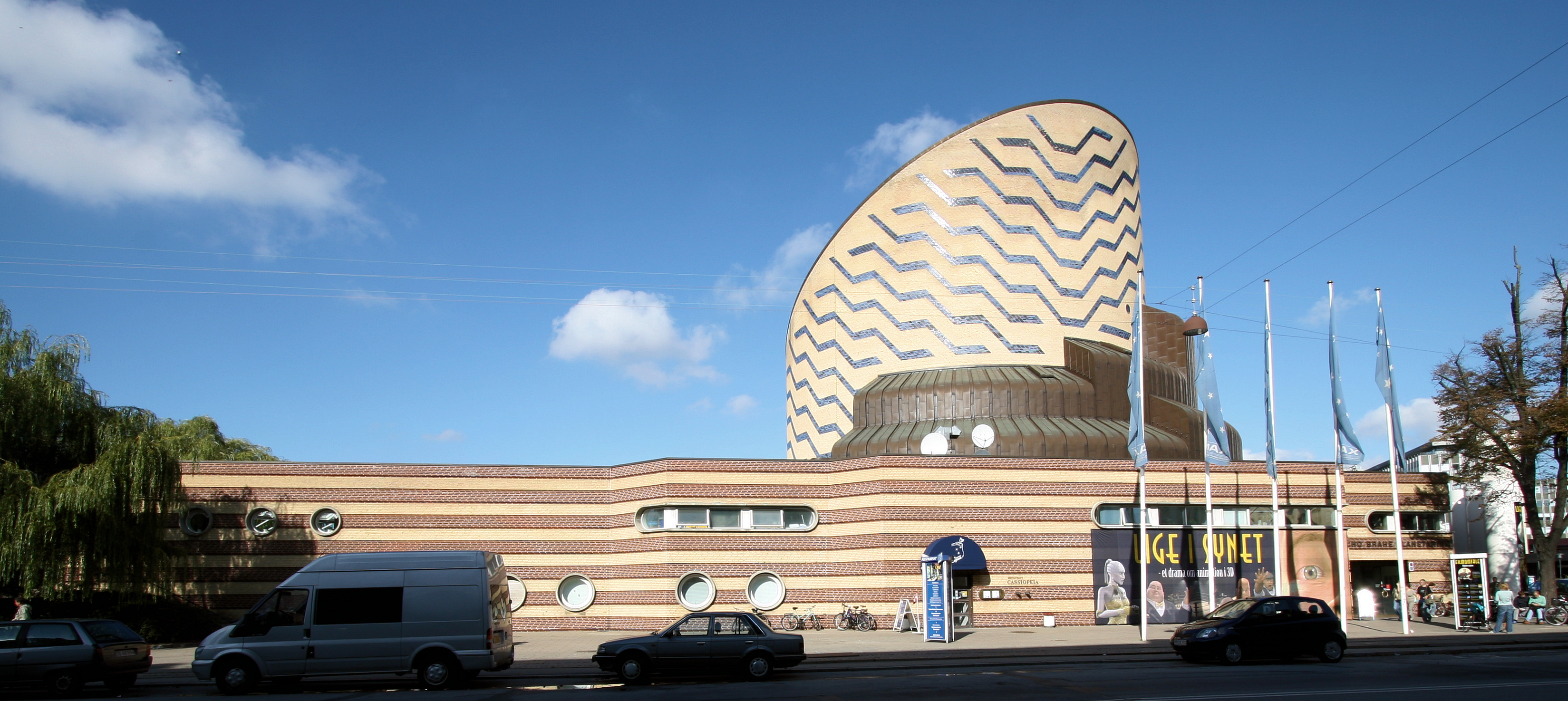
Tivoli Gardens. Celebrating its 175th anniversary this year (1843), this amusement park is a tasteful version of Bakken just north of Copenhagen. At the back are 25 amusement rides, some for little kids but most deluxe G-force rides that make some people vomit. To get to the rides, pass ponds and flowers and a mind-boggling 43 restaurants. If that were not enough, there are 21 fast-food stands. And just outside is a food court! There are several open stages with pantomime and rock concerts on Fridays and a concert hall. Open primarily in the summer, its hours are 11 to midnight. DK120 to enter and multiples of DK30 for the rides.
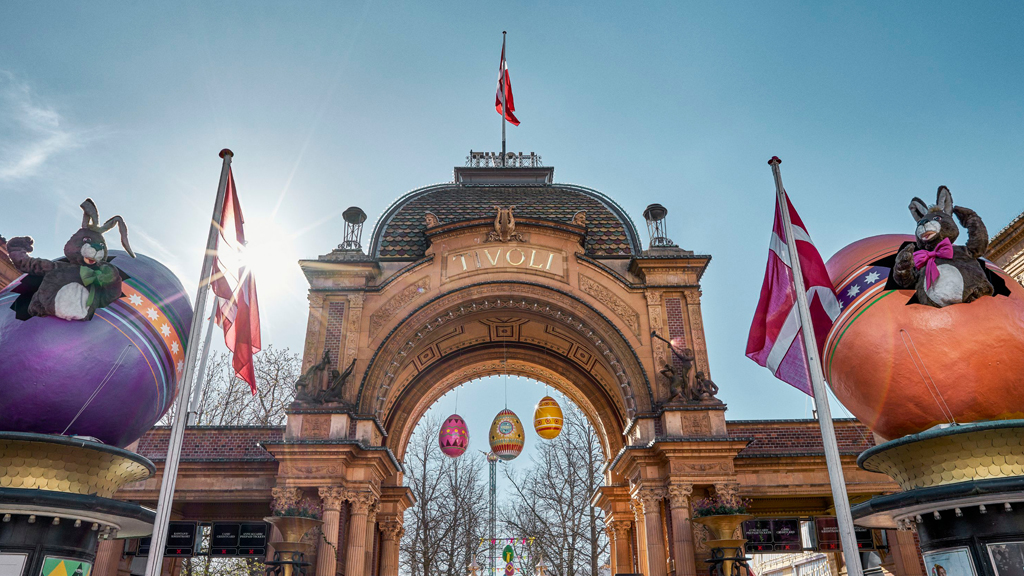
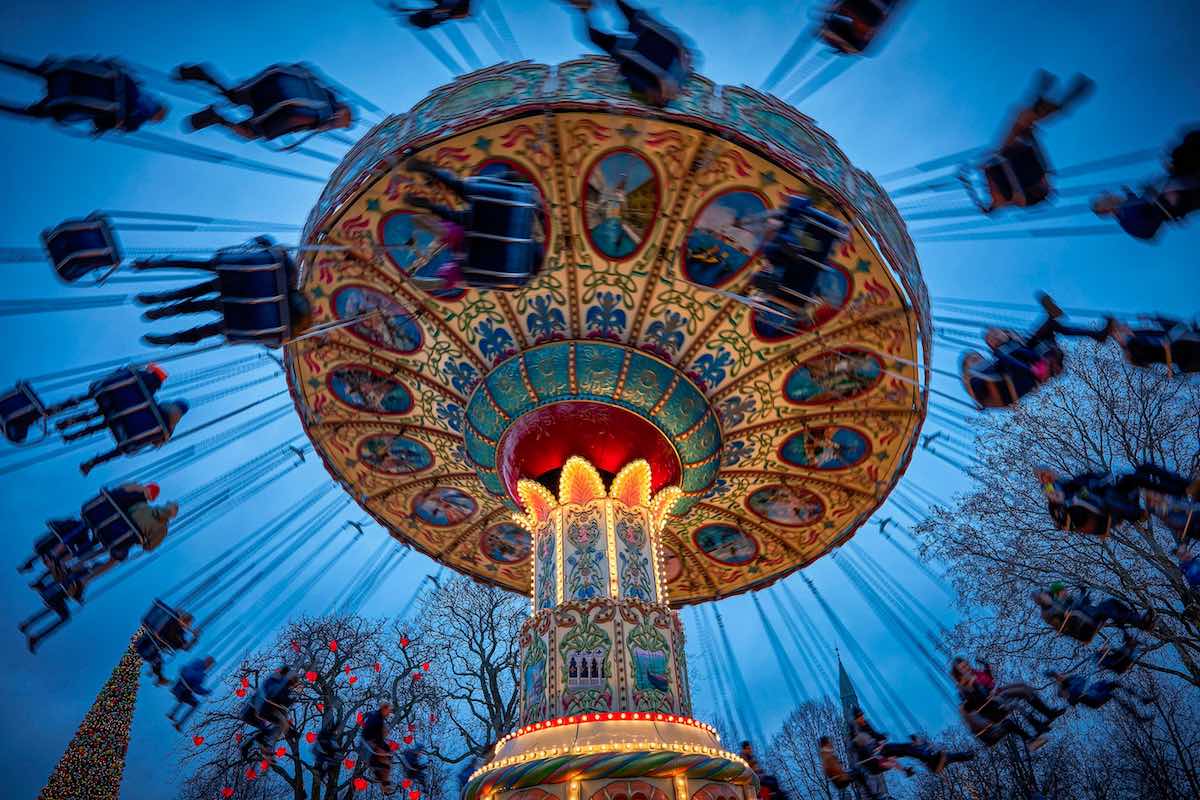
Central Train Station. In an old brick building, the massive wood-barrel roof covers shops and food services. The trains depart underground to all of Denmark but also to Sweden.
I parked on the street 50m from the planetarium – there appeared to be no parking fees! It was close to Tivoli Gardens and the Central Train Station (which has MacDonalds for Wi-Fi), but there is no metro stop nearby.
Day 2/14
I Googled shower in Copenhagen – it said that there was one at the train station. It ended up being at a sports complex nearby (read tips above) so I had a much overdue shower for a good start to the day. This was to be a heavy museum day as I had only 48 hours on my museum card to see the majority of sights in Copenhagen and I was off to see the first one at 10 am.
Ny Carlsberg Glyptotek. It didn’t open till 11 am, but stays open until 10 pm so I saw it in the evening. This is an eclectic mix of art in two collections: northern European antiquities and 19th century Danish and French art.
National Museum. It has claims on virtually every antiquity uncovered on Danish soil and doesn’t disappoint. This was the best exhibit on prehistory I have ever seen (every museum has one) and I learned lots of little tidbits I have never seen elsewhere. The display on flint cleared my mind about the deposits in the Møn’s Klint (flint is a type of quartz formed 50 million years ago from silica derived from dead diatoms and then torn from the subsoil by glaciers and spread all over Denmark) and the progression of man’s evolution and the start of civilization in brief easy-to-follow explanations. Of course, the objects on display were some of the best in the world. The Giendestrup Cauldron was a huge bronze cauldron with fantastic metalwork. There was great gold.
As I have visited almost every museum in Denmark till now, much of the rest was a good review. One thing they didn’t have was the great bog men found in Silkeborg and Moesgaard. DK95
Prince’s Palace. In the NM “Castles, palaces and Forts” series, this is now an administrative block around a small square next door to the National Museum and is not open to the public.
Thorvaldsens Museum. Bertel Thorvalsens (1770-1844) was a famous Danish sculptor. He lived most of his life in Rome and produced an enormous volume of work – virtually anyone famous you can think of. He moved back to Denmark for the last 5 years of his life and bequeathed his massive collection to the country. It took 2 ships to carry it all and the king provided this great building to house it all in. The process of producing fine marble sculpture involves making it in clay, then plaster, and then in marble (he primarily used Carrera marble). Most of what is here is plaster – as evidenced by any piece that looks dirty. The final marble productions were sold all over Europe. To see his most acclaimed work, the 1839 Christ and the Apostles, visit Vor Frue Kirke, Copenhagen’s current cathedral.
Also here is his large personal collection of furniture, drawings, paintings, and Mediterranean antiquities (the cameos were amazing). It is all housed in a lovely building with frescoes covering all the ceilings and some of the walls. DK70


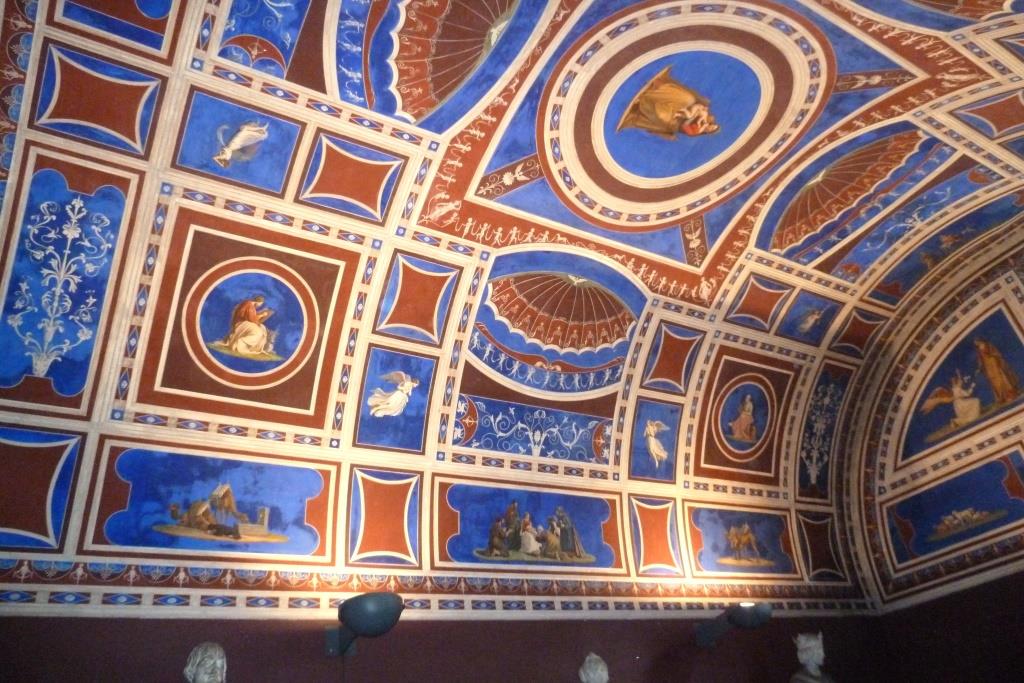
Christiansborg Palace is next door, but as I was exiting Thorvaldsens, I was hustled away as Daniel Macron, the French President was also visiting Christiansborg. From deciphering several clues from the machine gun-toting police, I figured out the entrance and time but couldn’t be bothered to wait.
Rundetaarn. Part of Trinitatis Kirke (Trinity Church), it served as the university observatory and library (1637-43). Walk up the great spiral ramp and stairs to the top of this high tower for the best views of Copenhagen. Great signs point to all the buildings – it was amazing how many copper-spired churches there are in the city. On the way up visit the library (held the university book collection from 1657-1861 and now had a nice exhibit of large abstract weaving), latrines, bell loft, and peer down the hollow central core of the tower. At the top is the Ole Romer Observatory. DK25
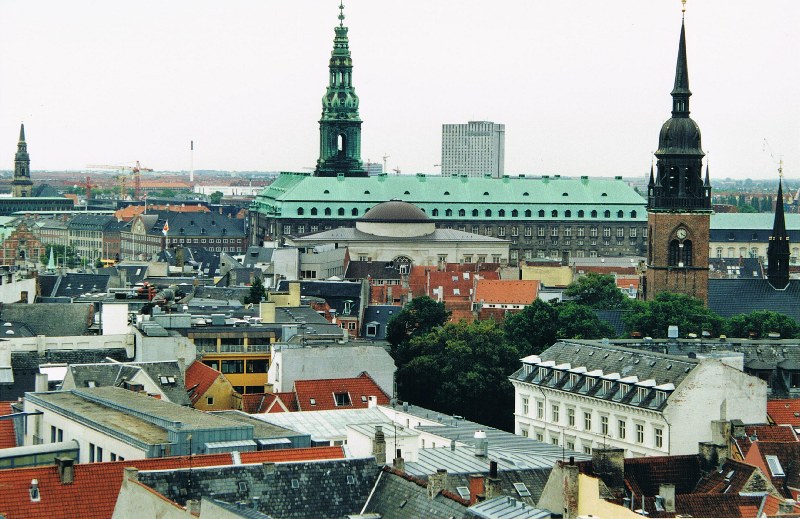
On my way to the next museum, I took a wrong turn and ended up walking by a synagogue guarded by machine gun-toting military. There had been a 2015 assault here when a converted Islamic militant killed a guard after terrorizing a café. I love talking to all these guys with big guns – finding out what is going on, what kind of gun they are using, and about their job.
Worker’s Museum (Arbydecmuseet). The building was originally built as a worker’s community centre in 1878 and has good displays on children workers (legal until 1873 if under 10), working at the port, a Danish working family, industry and the evolution of unions and their role in producing the social country Denmark is today. The highlight is the beautiful Assembly room with its ceramic ceiling and wonderfully carved wood bas-reliefs showing all the crafts and trades. DK50
Hirschprung Park Museet was closed (open Wednesday to Sunday – hours 11-4), it was a long walk out of my way, but I came back on Wednesday.
Statens Museum for Kunst. Denmark’s National Art Gallery straddles a great brick building and a modern glass-windowed addition. It has little that interested me – I am pretty tired of Danish art since 1900 (most of it lousy attempts at abstracts and installation art), Renaissance art (mostly religious), and others I don’t like much (Picasso, Matisse). I did enjoy the Danish Golden Age art, most of the artists I have now seen many times. DK110
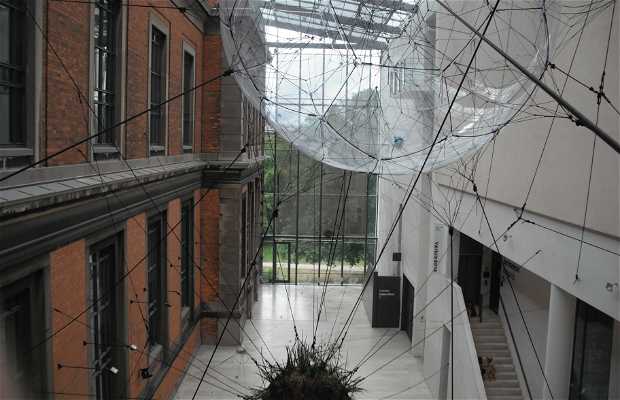
Kongens Have. The oldest park in Copenhagen from the 17th century, it has immaculate flowerbeds (the rose garden is superb) and winding paths amongst big trees. Rosenberg Slot is on the north side.
Rosenborg Slot. This is a moated palace in the Danish Royal Collection. Built between 1606 and 1633 by King Christian IV in Dutch Renaissance style to serve as his summer home, it is now chronologically arranged to house the furnishings and art of each monarch until Fredrik VII. It is all dark-styled rooms full of their knick-knacks. But some of it is interesting: wonderful ceilings, the Marble Room, the Mirror Room, the huge collection of Venetian glass and East Asian porcelain, and Queen Sophie’s ivory lathe. The thrones are made of narwhal tusks and fronted by 3 great silver lions.

The highlight is the Treasury in the basement with dazzling crown jewels and a spectacular collection of ivory and amber. DK75
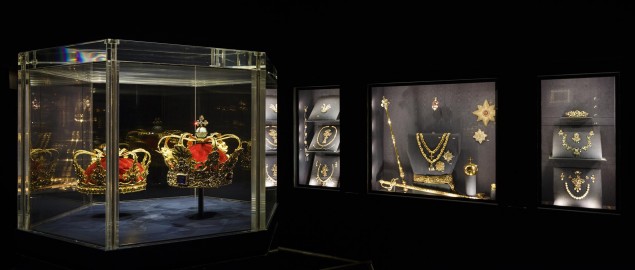
The David Collection. Christian Ludvig David (1878-1960) inherited a fortune that he increased substantially. He donated his collections to the museum housed in a 19th-century home and a neighbouring building that was renovated from 2005-9. There are three collections: 1. European 18th-century art, furniture, and decorative art including porcelain from Denmark, France, and Germany and furniture from England and that of David Roentgen 2. Danish paintings and sculptures from 1880-1950 including works by Vilhelm Hammershøi, Philipsen, Villumsen, and the Funen painters and 3. Islamic art from the 7th century to 1850 was exhibited in chronological and geographical order; this is internationally acclaimed.
I especially enjoyed the photographic exhibit by Tocher Huus called “Hippy Trail” about his travel adventures in the 60s and 70s (Turkey, Iran, Afghanistan, Copenhagen). Free
Jane Koenig Jewelry Store. Near the south corner of Kongens Have, this minimalist store has 16 small glass cases showcasing the very nice, simple, classic jewelry of this Danish woman. The jewelry is sold in another store in Aarhus, a webshop, and selected jewelry stores all over Europe. It is in the NM “Things to Do” series.
I was exhausted after this gruelling “museum day” and dragged my ass the 30-minute walk back to the van.
Day 3/15
For my last full day in Copenhagen, I had planned another exhausting museum day, and was hot after it early. I took the train to Ostoport (B and C trains go there, it is the second stop), about a 15-minute walk to my farthest point, the Little Mermaid, and walked back to my sanctuary passing all these sights.
Little Mermaid. The iconic sight in Copenhagen, this small, underwhelming statue is easily the most photographed sight in the country and countless “is that it?” shrugs from tourists who have trudged the kilometre or so along the harbour front to see her.
In 1909, beer magnate Carl Jacobsen (Carlings) was impressed enough after seeing Hans Christian Anderson’s fairy tale “The Little Mermaid” that he commissioned sculptor Edvard Eriksen to create a statue for the harbour. The face is that of ballerina Ellen Price while Jacobsen’s wife is the body. She sits on three rocks on the edge of the water.
In 2006, a new genetically modified Little Mermaid was commissioned, sat a few hundred metres from the original but has now been removed and sent to Shanghai.
There are always huge crowds of tourists descending from their tourist buses. After seeing the Pissant, a famously small statue in a fountain in Brussels, I was led to believe the Little Mermaid was much small, but she is life-sized.

Kastellet Fort. 5 minutes from the mermaid, enter the north entrance to this star-shaped fort. Surrounded by a double moat and a large embankment, the space has cobbled streets and a lot of 3-story red buildings that serve as offices.
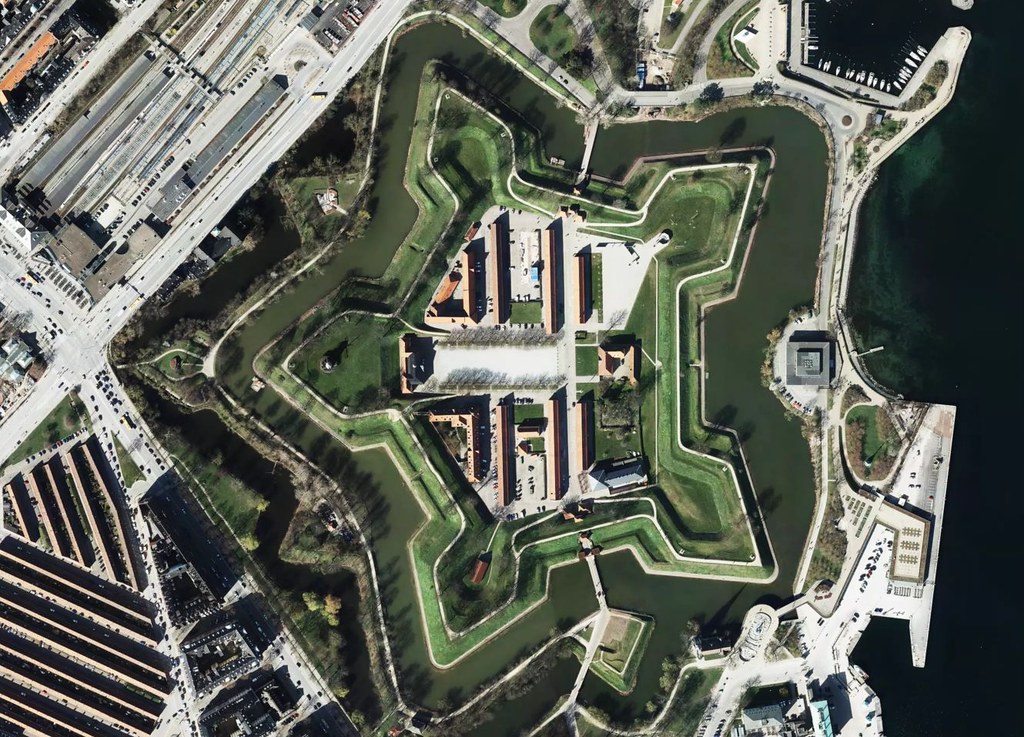
After the gate, turn right to go up onto the embankment and walk to Kastellet Mølle, a non-functioning windmill with a red base. Exit the south entrance.
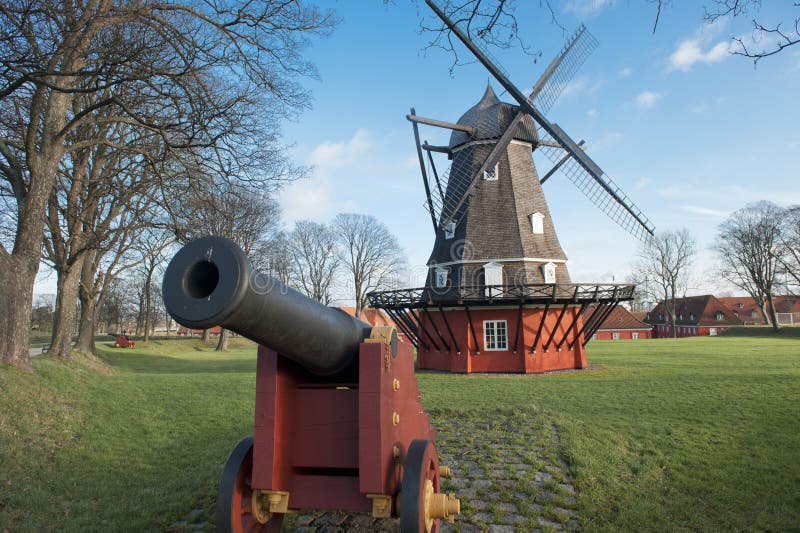
Danish Museum of Art & Design. The 18th-century Frederiks Hospital is now this outstanding museum of applied arts and industrial design. The collection includes Danish silver and porcelain, textiles, and furniture. The chair displays are outstanding and demonstrate the principles of Danish design developed in the 50s and 60s – minimalist, soft, organic shapes with clean surfaces without ornamentation. There was a display on Danish Now and how Danish design has progressed since the 90s. There are also Chinese, Japanese, and European displays covering design from the late 1800s when London’s V&A Museum was the first devoted to design. Displays show beautiful art nouveau pieces by Tiffany and Emile Gallé, Meissen porcelain, Ming porcelain, oriental rugs, tapestries, and a good display of Toulouse-Lautrec posters. DK115
Hirschprung Collection. With short opening hours of Wednesday to Sunday, 11-4, it was again a long walk out of my way to see it on Tuesday, a long walk out of my way to see it on Wednesday, and it was still closed.
It houses a large collection of Danish art from the 19th and early 20th centuries. The emphasis is on the Danish Golden Age, from 1800 to 1850, but also the Skagen Painters and other representatives of the Modern Breakthrough are well represented.
The museum is built around the personal art collection of Heinrich Hirschsprung, a tobacco manufacturer, and patron of the arts who founded his art collection in 1865. Almost four decades later, in 1902, he donated it to the Danish state. It is displayed in a purpose-built Neoclassical museum building designed by Hermann Baagøe Storck and completed in 1911.
The smaller galleries of the museum are furnished with furniture designed by the Golden Age artists and other provenance furniture associated with them.
Marmorkirken (Frederik’s or Marble Church). This gorgeous round church in grey stone has a massive dome with 12 apostles around the circumference. There are 3 galleries, the first with 12 mosaics of animals, the second with blue/white glass, and the third at top of the dome. Climb to the top of the dome once a day at 1 pm sharp for DK35.

Amalienborg Slot. Home of the current queen, Margrethe II, this is four austere, 18th-century palaces around a large cobble square. The changing of the guard occurs every day at 11:55 (arrive at about 11:45 and stand near the right portico for the best views). I waited about 30 minutes to see the great performance – in great fur hats made from Canadian black bears, a band accompanies the 14 guards (they work 24-hour shifts – 2 hours patrolling, then 4 hours off to sleep and do other duties). The show lasts an hour and then the band marches back through the streets to their garrison (I met them at 1:30 on the streets). The music is great.

Frederik VII died childless and the Glucksberg family (distant relatives from Germany) started this line of Danish royalty. The queen lives in the large palace across from the main entrance and Frederik, the heir apparent, is in the palace next to the museum. Hers is the only one with 5 chimneys – joked about as she is a chain smoker. I sat to have a smoke and was politely told that I couldn’t sit on the steps.
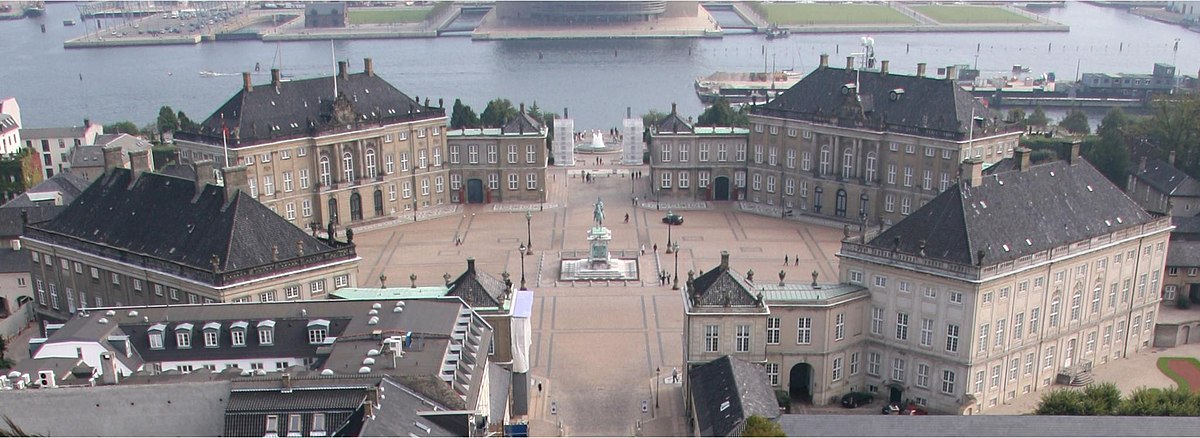
In the museum, see the royal apartments used by three generations of monarchs from 1863-1947, each reconstructed with a jumble of gilt-leather tapestries, trompe l’oeil paintings, family photographs, and antiques. Each room gives a good discussion of each monarch and their popularity – or not – with the Danish public. The present queen is mainly popular with those over 35 and less so with the youth as taxes pay for her support. Frederik, the heir apparent has done a lot to improve this as he married an Australian commoner and does many popular things. DK75
Nyhavn. This one-street neighbourhood on the west side of the Nyhavn canal (built to connect Kongens Nytorv to the harbour) is one of the tourist magnets of Copenhagen with coloured gable townhouses, quayside cafes, herring buffets, and beer. Originally it was the Red-light district and full of bars. Hans Christian Anderson lived along the canal in 3 different houses for over 20 years.
Charlottenborg Slot (Kunsthal Charlotenborg). On the east side of Nyhavn Canal, this palace now functions as an art museum with a new exhibition each month. The present exhibition, CHART with modern art, is part of a 10-gallery exhibition all around Copenhagen and was just being set up so the galleries were closed. Free
Christiansborg Palace. This is a palace and government building in central Copenhagen. It is the seat of the Danish Parliament (Folketinget), the Danish Prime Minister’s Office and the Supreme Court of Denmark. Also, several parts of the palace are used by the Danish monarch, including the Royal Reception Rooms, the Palace Chapel and the Royal Stables. It is thus home to the three supreme powers: the executive power, the legislative power, and the judicial power – the only building in the world that houses all three of a country’s branches of government.
The present building, the third with this name, is the last in a series of successive castles and palaces constructed on the same site since the erection of the first castle in 1167. Since the early fifteenth century, the various buildings have served as the base of the central administration; until 1794 as the principal residence of the Danish kings and after 1849 as the seat of parliament.
The palace today bears witness to three eras of Danish architecture, as the result of two serious fires. The first fire occurred in 1794 and the second in 1884. The main part of the current palace, finished in 1928, is in the historicist Neo-baroque style. The chapel dates to 1826 and is in a neoclassical style. The show grounds were built in 1738-46, in a baroque style. De Kongelige Repræsentationslokaler is the highlight of Christiansborg, this ornate Renaissance hall is where the Queen entertains heads of state
There are several museums associated with the palace, the following three and a Theatre Museum.
Denmark War Museum (Krigsmuseet or the Royal Arsenal). This shows the progression from sail to steam, wood to steel and muzzle loading to breach loading to torpedoes and missiles. The ground floor has a 160m long collection of cannons and some artillery and the second has displays on the Danish navy from the early 16th century and the 21 wars Denmark has been in. There is a good brief explanation of each war and the result including Iraq and Afghanistan and the roles Denmark played in the Cold War and NATO. The two most interesting displays were the original Union army uniforms from the US Civil War (even the US doesn’t have these) and one on German uniforms and weapons from WWII when Germany occupied Denmark. DK75
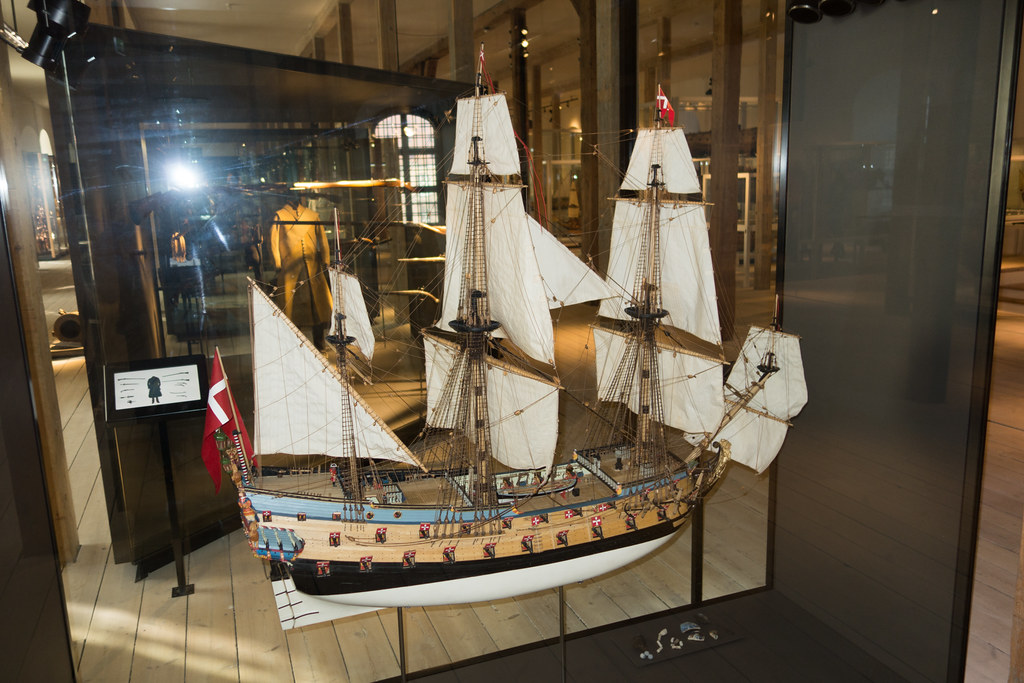
Royal Stables. The small museum has Perlan, Frederik VII’s stuffed white horse and a great collection of saddles. Then enter the stables with 12 gorgeous Kladrube white horses from the Czech Republic (born dark and turn white when 6-7 years old). The carriages are all still used by the Danish Royal Family. DK50

National Museum of Photography. This is one of the more unusual museums as it consists of a digital file with appointments necessary to see the real photographs. It is also hard to find – it is in Det Kongelige Bibliotek, the Royal Library – housed in the Black Diamond. During the day this leaning parallelogram of black granite and smoke-coloured glass appears all black, but at the centre is lit clear to show the soaring atrium with an escalator that leads up to the 210 sq. metre mural and the ‘old library’ with its old-fashioned reading room with desk lamps and classical columns.
In the basement gallery, there was an interesting photographic exhibit “Gaza Works” by the Swedish-born photographer Kent Klich, who has been documenting the horrors of the Gaza strip since 2000. This 360 sq. km piece of land with 2 million residents has been called the largest open-air prison in the world. The Gaza International Airport, opened in 1998 was closed in 2000 and demolished by the Israelis (visit a plane sitting on the tarmac). Even though Gaza was officially unoccupied by Israel since 2005, since 2007 when Hamas became the government, it has been subject to Israeli blockades for both goods and people. The 2008/09 raid on Gaza by the Israelis left 50,000 homeless and on Black Friday, during a supposed ceasefire, 130 were killed.
Klich made his name by chronicling the life of Beth, a Danish sex worker over 30 years, El Nino (a book on homeless children in Mexico), and Children of Ceaucsue (a 2001 book about HIV+ children in Romania’s orphanages). DK50
Ny Carlsberg Glyptotek. This museum was founded by Carl Jacobsen (1842-1914), one of the great industrial magnates of the 19th century and the greatest art patron Denmark has seen. A passionate collector, he used the profits of his brewery to build a world-class collection of art. He built this wonderful 2-story building in 1897 and centred it around a winter garden.
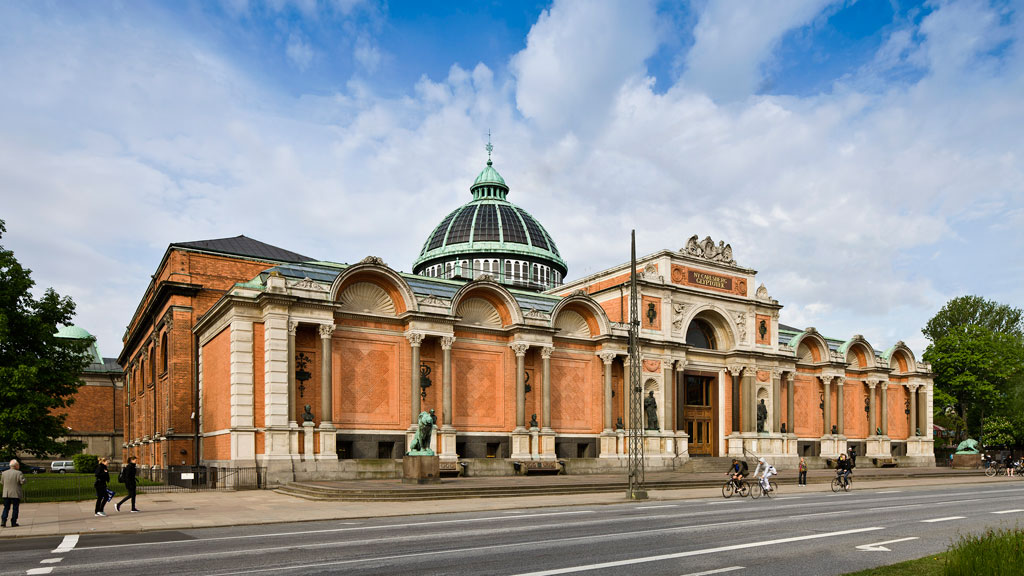

This art museum has two collections: north European antiquities and 19th century Danish and French art. This is the largest collection of Rodin Sculpture outside France, 47 Gauguin paintings, and several of the greats – Cézanne, Van Gogh, Pissaro, Monet, and Renoir. The Danish Golden Age is also well represented on the second floor. The French painting exhibit was unfortunately closed when I was there.
The highlight for me was the exhibit on the 1830 discovery in Berthouville, Normandy that uncovered a Gallo-Roman sanctuary dedicated to Mercury. The 25kg of silver found is outstanding. DK110
V1 Gallery. This is a very quirky, small museum south of the railway station. If approached from that side, it is also hard to find in a maze of buildings. The front has a few pieces of modern art, then goes downstairs to a small room with a B&W exhibit of surfing photos and then 100m down an alley to another gallery with some geometric abstracts by Barry McGee from San Francisco. Exhibit rotate. Free
Museum of Copenhagen. Despite taking a few wrong turns, I made it to this last museum of the day at 4:50 pm, just before it was to close. But it looked like it had been closed for years – the gates were locked, the grass overgrown and rising out of the cracks in the brick driveway. Free
I had planned the day perfectly and dragged my ass back to the van, only 5 minutes from my endpoint.
Copenhagen Canal Cruise. After a light dinner of salad, I walked the 35 minutes back to Nyhavn to take a canal cruise through Copenhagen’s harbour and canals. I just missed the 8 pm boat but took the 8:30 for the hour trip that starts at the north end of Nyhavn.
Don’t miss doing this. Despite having walked almost everywhere in Copenhagen over 3 days, there were many places I hadn’t seen: the $500 million Opera house in Christianshavn was gifted to the city by Maersk Shipping, completed in 2005, and would be an architectural highlight anywhere.
The large industrial structure with all the smokestacks at the east end of the harbour is a giant incinerator that burns 60 tons of garbage an hour to produce electricity. Copenhagen doesn’t have that much garbage and imports it.
We passed the royal yacht, the swank boat the Queen regularly travels in.

There’s a bungee jump from a crane.
The cruise went through the canals of Chrisitanshavn lined with boats (20-year waiting list for an expensive berth). Two artificial islands with canals were built by Christian IV in 1618 to create Christianshavn – a mini-Amsterdam meant to attract Amsterdam merchants to Copenhagen (it didn’t). He had to give 11 years of the tax-free liver to get people to live here.
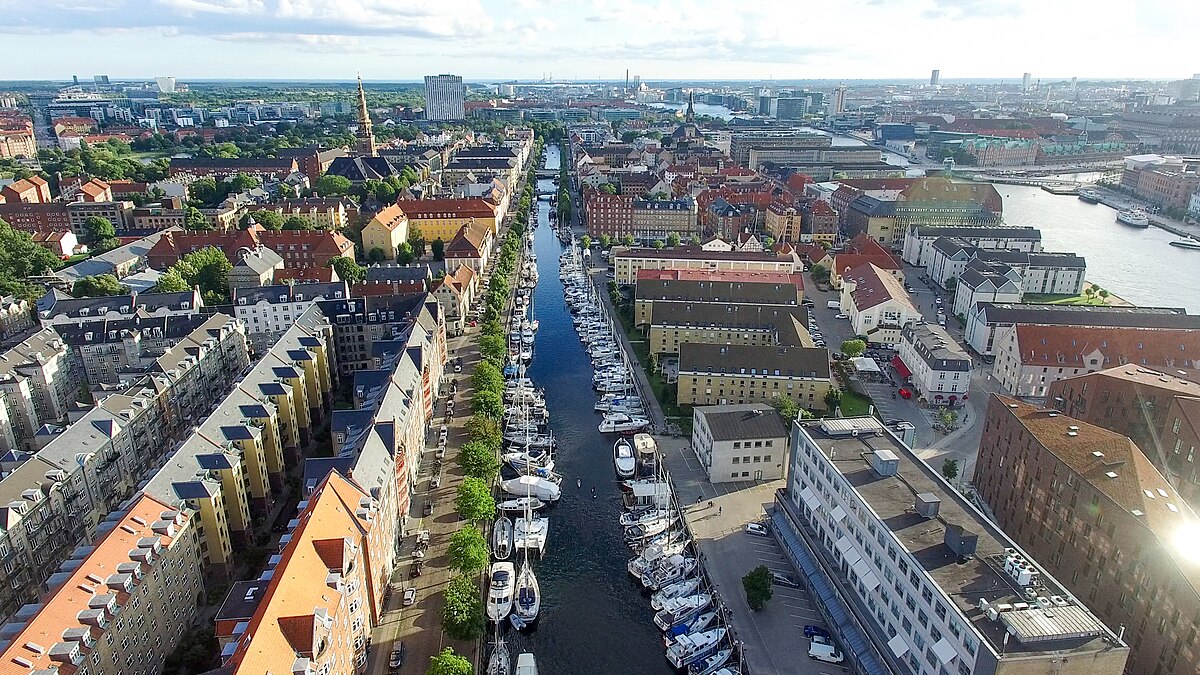
At the entrance is the pretty butterfly bridge.
The Black Diamond is black in the day but has a completely clear glass center showing the white interior.
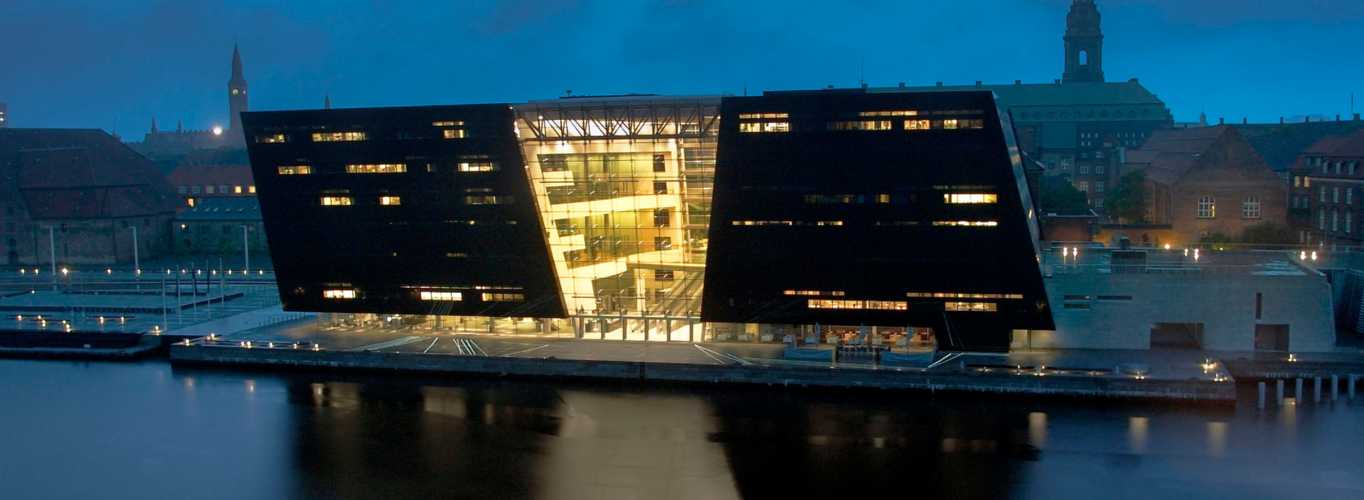
The Old Stock Exchange is an architectural wonder with its Dutch Renaissance design and spiral tower formed by the tails of three dragons. DK95
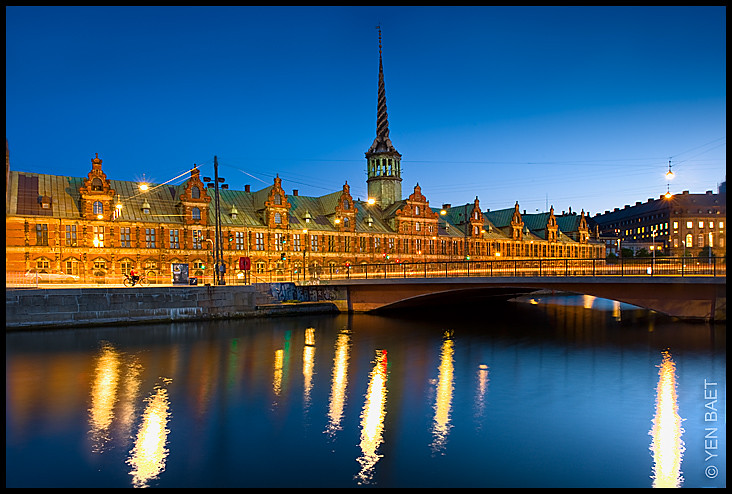

Day 4/15
My Copenhagen card was to run out at 11:45 and I had to rush to see all these, all reached by car. Grundvigs opened at 9 and Peder Skram at 11, my timing was perfect. It was a rainy, cool day and I’m glad I didn’t have to walk.
Grundvig’s Church. About 6kms north of the city centre, it is in the NM “religious temples” series. It has weird hours (Tues, Fri 8-12, Wed 9-1, Thurs 9-1 & 4-6 and closed Sat, Sun and Monday). So I didn’t see the inside and went back on Thursday early.
It was built as a memorial to the priest, hymn writer, and educator Nikolaj Frederik Grundvig (1783-1872). Started in 1921, it was not finished until 1940 and was funded by all Danes from all over the world. The size of a cathedral, this monstrous cream brick edifice (5 million bricks were used), has one of the most massive but austere interiors of any church I have ever seen. The high, clear-glass windows give a lot of light but nothing adorns the walls. It is 76m long, has vaults 22m high and seats 1,440, has a tower 49m high, and stands on a hill 31m above sea level. The organ has the longest pipes of any in Scandinavia.
Everything is high from the narrow aisles to the faceted brick columns and everything but the wood doors, organ surrounds and chairs, is cream-coloured brick.
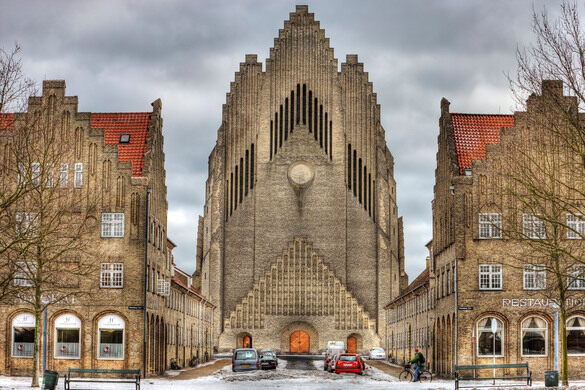
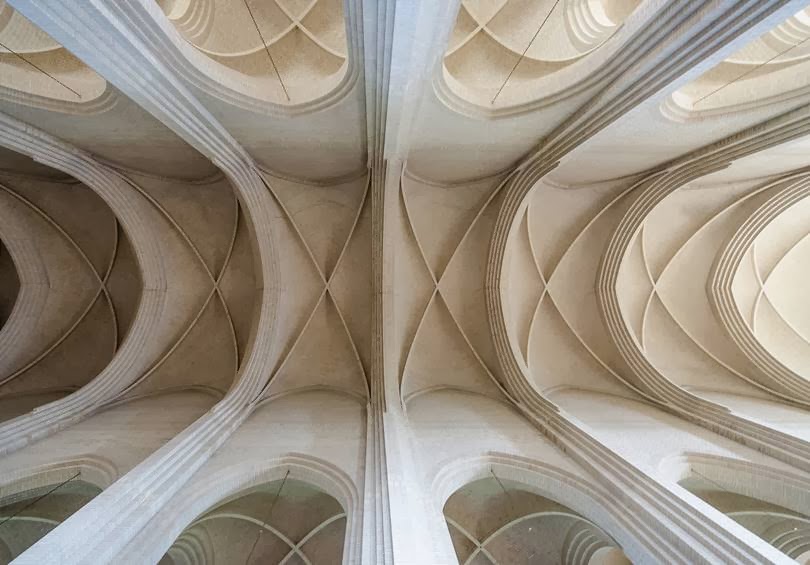
Carlsberg Visitors Centre. This felt more like a museum rather than a brewery tour as it goes through the original 1847 brewery with no brewery. Start at the racks of 16,384 unopened beer bottles – the Carlsberg label is the most widespread piece of Danish design. Displays tell the history of beer and Carlsberg (began in 1887, it was named after his son, Carl) including its amalgamation with Tuborg in 1970. Visit the stables with the Carlsberg horses and finish at the brewery where the tour is in Danish and get your free glass of beer. Tours are in Danish. DK100
Diesel House. The Ørsted Power Plant started this diesel power station in 1937 to compensate for peak demands in Copenhagen’s electrical supply. Diesel plants have a much faster start-up time than steam turbines. For 30 years, it was the largest diesel engine in the world (8 cylinders with a bore of 840mm, a stroke of 1500mm, and 115rpm) and was operational until 2003 when it was disconnected from the grid. It is very big. Walk around it. Tours are in Danish. Free
HDMS Peder Skram frigate. In the National Museum of Naval History on the south side of the harbour, this Royal Danish Navy frigate was in use until 1990 (Peder Skram was a 16th-century Danish admiral). It was an innovative design using a hybrid propulsion system, a combined gas turbine and diesel. It is famous for the 1982 accidental launch of a Harpoon missile, that destroyed several houses but inflicted no bodily harm. It was decommissioned in 1990, internal installations were auctioned off as scrap and was restored as a ship museum run by volunteers and is only open for tours from June 30 to August 19th and October 13-21.
Sælen Submarine. This submarine sits on a cement cradle on the dock. It was built for the Norwegian Navy in Germany in 1965 and bought by Denmark in 1990. It was posted to the Mediterranean as part of Denmark’s NATO functions after 9/11 and then again in 2003 when it monitored sea traffic in the Straits of Hormuz in the Iraq war. Denmark stopped its submarine program in 2004 and the Sælen was decommissioned.

HDMS Selested (P547). Another NM “Ship Museum”, it sits in the water between Peder Skram and the Sælen in front of an old port crane in the Royal Navy Museum. It was a Willemoes-class fast attack craft in commission from 1978 until 2000. It was named after Hannibal Sehested, a 17th-century Danish statesman. It is a fast attack craft built for the naval defense of Denmark during the Cold War. The eighth of ten ships of her class, Sehested was built at Frederikshavn Shipyard. The 46-meter 264-tonne ship armed with a 76 mm autocannon on the foredeck, flanked by two 533 mm (21 in) torpedo tubes. Six 103 mm (4 in) rocket launchers were fitted to the superstructure, and there were eight Harpoon anti-ship missile launchers at the stern. The ship also carried sixteen mines, two Stinger surface-to-air missiles, and Seagnat chaff launchers. The vessel was powered by three Rolls-Royce Proteus gas turbine engines on the three shafts, while there were two GM 8V71 diesel engines on the outer two shafts only to provide low-speed maneuverability. In 1999 P547 Sehested achieved a top speed of 42.5 knots, which was the highest recorded and documented speed, for the Willmoes Cl. ever achieved. Shark teeth painted on the ship. In 2000, it was decided to phase out the Willemoes class, and Sehested was decommissioned in 2000. She was handed over to the Royal Danish Naval Museum and docked at the historic Holmen naval base in Copenhagen to serve
as a museum.


Dragør. In the NM “small town” series, I drove 16 km southeast to see my last ‘sight’ in Denmark. This village is actually far enough from Copenhagen that you pass through fields to get there. It sits on the sea with a museum on the marina and a small downtown but not much else.
Den Bla Planet (National Aquarium Denmark). On the ocean at Kastrup, a suburb of Copenhagen, this opened in 2013 in a spectacular-looking aluminum-clad building. It resembles a whirlpool when seen from above and contains about 7 million litres of water divided into 53 exhibits: the main categories are the rainforest, the African Great Lakes, evolution and adaption, cold water, the warm ocean (in the largest aquarium here, the 4 million litre Ocean tank) and water (native Danish species from fresh and saltwater). DK100

I ended up seeing everything in Copenhagen and the surrounding area on the Nomad Mania list except the Copenhagen Zoo, one thing I don’t enjoy as I’ve seen almost everything live in their natural environments, the Kroppedal Museum of Astronomy and ARKEN, a contemporary art museum.
After going to Dragør, I went to the aquarium. For the first time in 7 months, the Macdonalds at the Danish side of the bridge had a one-hour parking limit with an obsessive attendant. This is how I learned about the parking ‘clock’. Kastrup, Copenhagen’s international airport is next door to the Macdonalds, 9kms from central Copenhagen and there was nowhere free to park but I slept in an ungated area that I was kicked out of in the morning and then crossed the Öresund Bridge from Copenhagen – it ends at Malmo, Sweden.
ØRESUND or ÖRESUND BRIDGE
This combined railway and motorway bridge across the Øresund strait between Sweden and Denmark is nearly 8 kilometres from the Swedish coast to the artificial island Peberholm in the middle of the strait. The crossing is completed by the 4-kilometer Drogden Tunnel from Peberholm to the Danish island of Amager.
The Øresund Bridge is the longest combined road and rail bridge in Europe and connects two major metropolitan areas: Copenhagen and Sweden’s Malmö. It connects the road and rail networks of the Scandinavian Peninsula with those of Central and Western Europe. A data cable also makes the bridge the backbone of internet data transmission between central Europe and Sweden.
The international European route E20 crosses via road, the Oresund Line via railway. The construction of the Great Belt Fixed Link (1988-1998), connecting Zealand to Funen and thence to the Jutland Peninsula, and the Øresund Bridge has connected Central and Western Europe to Scandinavia by road and rail.
The justification for the additional expenditure and complexity related to digging a tunnel for part of the way, rather than raising that section of the bridge, was to avoid interfering with air traffic from the nearby Copenhagen Airport, to provide a clear channel for ships in good weather or bad, and to prevent ice floes from blocking the strait.
In accordance with the Schengen Agreement and the Nordic Passport Union, there are usually no passport inspections. There are a few random customs checks at the entrance toll booths entering Sweden, but not when entering Denmark. Since January 2016, checks have become significantly more stringent due to the European migrant crisis.
History. Construction began in 1995, with the bridge opening to traffic on 1 July 2000.
The concept of a bridge over the Øresund was motivated to improve transport links in northern Europe, from Hamburg to Oslo, regional development around the Øresund, to connect the two largest cities of the region and improve connections to Kastrup airport, the main flight transportation hub in the region.
Although traffic between Denmark and Sweden increased by 61 percent in the first year after the bridge opened, traffic levels were not as high as expected, perhaps due to high tolls. However, since 2005, traffic levels have increased rapidly. This may be due to Danes buying homes in Sweden to take advantage of lower housing prices in Malmö and commuting to work in Denmark. To cross by car costs DKK 310, SEK 375 or €43, with discounts of up to 75% available to regular users. In 2007, almost 25 million people travelled over the Øresund Bridge: 15.2 million by car and bus and 9.6 million by train. By 2009, the figure had risen to 35.6 million by car, coach, or train.
In January 2016, amidst the European migrant crisis, Sweden was granted a temporary exemption from the Schengen Agreement in order to mandate that all travellers across the bridge had photographic proof of identity. The move marked a break with 60 years of passport-free travel between the Nordic countries.
Bridge. At 7,845 m (25,738 ft), the bridge covers half the distance between Sweden and the Danish island of Amager, the border between the two countries being 5.3 km (3.3 mi) from the Swedish end. The structure supports two railway tracks beneath four road lanes in a horizontal girder extending along the entire length of the bridge. On both approaches to the three cable-stayed bridge sections, the girder is supported every 140 m (459 ft) by concrete piers. The two pairs of free-standing cable-supporting towers are 204 m (669 ft) high allowing shipping 57 m of headroom under the main span, but most ships’ captains prefer to pass through the unobstructed Drogden Strait above the Drogden Tunnel. The cable-stayed main span is 491 m (1,611 ft) long.
The bridge experiences occasional brief closures during very severe weather, such as the St. Jude storm of October 2013.
Due to high longitudinal and transverse loads acting over the bridge and to accommodate movements between the superstructure and substructure, it has bearings weighing up to 20 t each. Vibration issues, caused by several cables in the bridge moving under certain wind and temperature conditions, were combatted with compression spring dampers installed in pairs at the centre of the cables.
Peberholm. The bridge joins the Drogden tunnel on the artificial island of Peberholm (Pepper Islet). Peberholm is a designated nature reserve built from Swedish rock and the soil dredged up during the bridge and tunnel construction, approximately 4 km (2.5 mi) long with an average width of 500 m (1,640 ft). It is 20 m (66 ft) high.
Drogden Tunnel. The connection between Peberholm and the artificial peninsula at Kastrup on Amager island, the nearest populated part of Denmark, is through the 4,050-metre-long Drogden Tunnel. It comprises a 3,510-metre immersed tube plus 270-metre entry tunnels at each end. The tube tunnel is made from 20 prefabricated reinforced concrete segments – the largest in the world at 55,000 tons each – interconnected in a trench dug in the seabed. Two tubes in the tunnel carry railway tracks, two carry roads and a small fifth tube is provided for emergencies. The tubes are arranged side–by–side.

Cost. The cost for the Øresund Connection, including motorway and railway connections on land, was DKK 30.1 billion (~€4.0 bn) according to the 2000-year price index, with the cost of the bridge expected in 2003 to be recouped by 2037. The connection will be entirely user-financed. The owner company is owned half by the Danish state and half by the Swedish state. Tax money has been used for the land connections. According to The Öresund Committee, the bridge has made a national economic gain of DKK 57 billion, or SEK 78 billion. The underwater parts of the bridge have become covered in marine organisms and act as an artificial reef.


